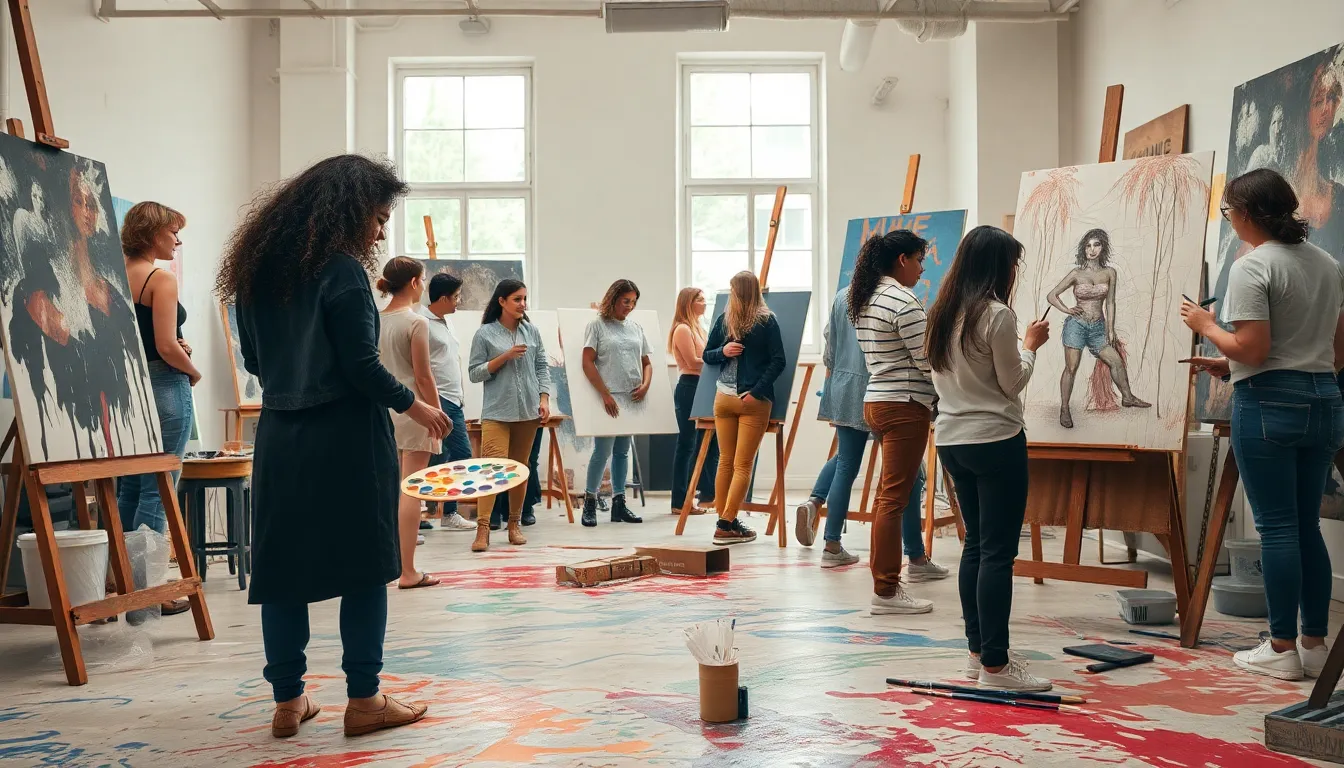Artistic inspiration can strike like a lightning bolt or sneak up like a cat on a sunny afternoon. Whether it’s the vibrant colors of a sunset or the quirky charm of everyday life, creativity often lurks in the most unexpected places. Artists, writers, and creators alike find themselves on a quest for that elusive spark, ready to transform the mundane into the extraordinary.
Imagine walking through a bustling city, where every corner offers a new idea, or flipping through a book that whispers secrets of creativity. Inspiration isn’t just a muse; it’s the fuel that ignites passion and drives artistic expression. So, buckle up and get ready to explore the colorful tapestry of artistic influences that can turn a blank canvas into a masterpiece or a simple idea into a creative revolution.
Table of Contents
ToggleUnderstanding Artistic Inspirations
Artistic inspiration is both a sudden spark and a gradual awakening. Creators often find motivation in various elements of life, leading to extraordinary expressions.
Definition and Importance
Artistic inspiration embodies the stimulation that drives creativity. This crucial force empowers artists, shaping their unique expressions and interpretations. Without inspiration, many creative endeavors might falter, lacking vigor. Recognition of its significance helps artists nurture their creativity and explore various ideas. Embracing inspiration encourages artistic growth and innovation, allowing creators to transform ordinary moments into captivating works.
Sources of Inspiration
Artists draw inspiration from myriad sources. Nature stands as a primary catalyst for artists, offering breathtaking landscapes and intricate details. Emotional experiences often become wellsprings for artistic expression, shaping narratives and visuals. Cultural influences serve as another essential source, enriching creative perspectives through history, traditions, and social contexts. Everyday objects and environments can also trigger creativity, inviting artists to see beauty in the mundane. Recognizing these sources can enhance creativity and expand artistic horizons.
Historical Context of Artistic Inspirations

Artistic inspiration is deeply rooted in history, drawing upon past movements and evolving thought. Historical contexts serve as a backdrop for modern creativity, enriching the artistic landscape.
Influences from Past Movements
Art movements like Impressionism, Surrealism, and Cubism provide rich sources of inspiration. Impressionism’s focus on light and color inspires contemporary artists to explore similar themes. Surrealism encourages the use of dreamlike imagery, often leading to innovative expressions. Cubism’s fragmented perspective opens new avenues for visual exploration. Previous movements shape current artistic practices and spark fresh ideas.
Evolution of Artistic Thought
Artistic thought has transformed significantly over centuries. The Renaissance marked a notable shift towards realism, emphasizing human experience and observation. Modernism introduced abstraction, challenging traditional forms and concepts. Postmodernism further questioned artistic boundaries, promoting diverse interpretations and methodologies. Each period contributes layers of complexity that influence today’s artists, pushing them to redefine their creative approaches.
Contemporary Artistic Inspirations
Contemporary artistic inspirations emerge from various dynamic sources. Artists harness creativity from technology and cultural influences in today’s interconnected society.
Impact of Technology
Technology significantly shapes modern artistic practices. Digital tools and platforms expand creative possibilities for artists by facilitating new methods of expression. Virtual reality creates immersive experiences, allowing audiences to engage in unique ways. Social media serves as a global canvas, enabling artists to showcase their work and connect with vast audiences. Innovations in software offer designers and illustrators tools for intricate designs that blend traditional techniques with modern capabilities. This technological influence fosters a culture of collaboration, inspiring artists to experiment with multimedia and interactive installations.
Cultural and Social Influences
Cultural and social contexts play crucial roles in contemporary artistic inspiration. Artists respond to current events, societal challenges, and cultural shifts, reflecting the complexities of modern life. Community-based projects encourage collaboration, bringing together diverse perspectives and experiences. Historical events shape narratives, prompting artists to address themes of identity, gender, and race through their work. Globalization exposes artists to various cultures, enriching their artistic visions and challenging conventional norms. Movements advocating for social change inspire creators to use their platforms for activism, fostering a connection between art and society.
Personal Artistic Inspirations
Artistic inspiration often comes from deeply personal experiences and the world around us. Nature and environment significantly shape creative expression.
Nature and Environment
Natural landscapes serve as profound sources of inspiration. Vivid colors in a sunset catch an artist’s eye, painting a picture of beauty. The rustling leaves in a forest resonate with feelings of tranquility, guiding the brush strokes in a painter’s work. Animals, both wild and domestic, evoke emotions that ignite storytelling and visual representations. Additionally, diverse weather patterns inspire varied artistic interpretations, ranging from serene to chaotic. Mountains, rivers, and oceans offer vast canvases for creativity, engaging artists to explore themes of solitude, movement, or impermanence.
Personal Experiences
Life experiences profoundly influence artistic direction. Moments of joy, heartache, or reflection weave narratives that resonate universally. Memories from childhood shape visual aesthetics and thematic choices, connecting individuals to their roots. Travel adventures broaden perspectives, introducing new cultures and forms of art that spark fresh ideas. Interactions with family and friends foster emotional connections that drive artistic expression. Additionally, navigating challenges, such as loss or resilience, often inspires powerful work that resonates with others, creating dialogue and empathy. Each personal experience enriches an artist’s journey, crafting unique interpretations that reflect their individual narrative.
Artistic inspiration is a multifaceted force that shapes the creative landscape. By embracing the unexpected and recognizing the beauty in everyday life, artists can unlock new dimensions of expression. The interplay of historical movements and contemporary influences further enriches this journey, allowing creators to draw from a vast well of ideas and experiences.
As technology and culture evolve, so too does the potential for inspiration. By remaining attuned to personal narratives and the world around them, artists can cultivate a deeper connection to their work. Ultimately, the pursuit of inspiration is not just about creativity; it’s about fostering a dialogue that resonates with others, inviting them to share in the transformative power of art.


